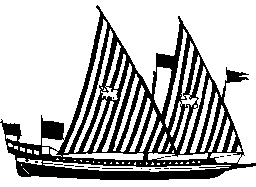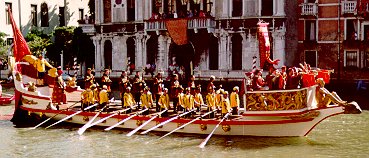HISTORIC
BOATS

The large historic ships
which made the Serenissima Republic so powerful deserve a
chapter of their own. They were divided into two
categories, round ships and narrow ships. The former,
characterized by their bulging shape, were destined for
sailing with goods which were not particularly valuable;
the cocche venete belong to this family. The
latter, the famous galleys (galee), were used
for the spice trade, for transporting precious goods and
as battleships.
The Galère (galleys) were
propelled both by oars and imposing lateen sails. The
oarsmen were initially made up of free men who were paid
for each voyage, but then, due to the lack of volunteers,
prisoners were used who were condemned to row for the
duration of their prison term. Living conditions were
terrible: more than two hundred men had to eat, sleep and
excrete on a narrow bench shared by other three or five
companions. It was said that the hygenic conditions were
so bad that before the galleys were sighted, they could
be smelt.
The hull of the galèra was about 40m long with
a width varying between 5 and 8m, it thus had a very high
length/width ratio similar to the gondola. Another
characteristic of the galleys were the sides which were
so low that, to avoid capsizing, a rule was introduced to
have sides of at least two Venetian feet (69.6 cm) on a
fully-loaded 40m-long ship! It is difficult to imagine
how they were able to navigate with sails having over 300
square metres surface area, and spars over 35 metres long
without capsizing, but there are records which show that
they regularly navigated not only in the Mediteranean
(Turkey, Egypt and Spain) but also as far as England,
Holland and Germany.
There were narrow galleys mainly for military use and
wider galleys for trade. There were also larger variants
such as the galeàzze used to start the battle
of Lepanto, and smaller types such as the fuste
and the galeòte.
Another historic ship is the Doge’s ceremonial boat, the Bucintoro, of which at least four similar examples were built over the centuries. The last, built in 1722, was an imposing vessel 100 Venetian feet long (34.8 m) which was decorated and gilded. The bucintoro had two decks: the lower deck was where the workers of the Arsenale rowed the 42 oars, the upper deck was reserved for the authorities, and at the stern on a special throne, the Doge. During the ceremony of the Sposalizio col mare, the Doge, at the entrance to the port of the Lido, threw a ring into the water which symbolized the Marriage of Venezia to the Sea.
Finally the  bissòne
are an ancient type of ceremonial boat, rowed by eight
costumed oarsmen. The boat was sumptuously decorated with
sculptures and allegorical carvings. It was used to
display or receive important people. Even today, ten of
these boats (reconstructions) make up the procession
during the Regata Storica. The themes illustrated by thes
boats are: Byzantine, Horses, China, Floral,
Geographic, Neptune, Pescantina,
Querini, Rezzonico, Venice.
bissòne
are an ancient type of ceremonial boat, rowed by eight
costumed oarsmen. The boat was sumptuously decorated with
sculptures and allegorical carvings. It was used to
display or receive important people. Even today, ten of
these boats (reconstructions) make up the procession
during the Regata Storica. The themes illustrated by thes
boats are: Byzantine, Horses, China, Floral,
Geographic, Neptune, Pescantina,
Querini, Rezzonico, Venice. ![]()